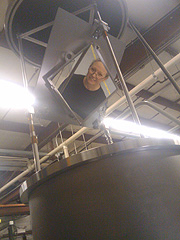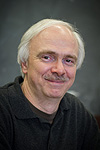Have a safe day!
Wednesday, Sept. 5
3:30 p.m.
DIRECTOR'S COFFEE BREAK - 2nd Flr X-Over
4 p.m.
Fermilab Colloquium - One West
Speaker: Artemis Spyrou, Michigan State University
Title: Nuclear Structure Along the Neutron Dripline
Thursday, Sept. 6
2:30 p.m.
Theoretical Physics Seminar (NOTE LOCATION) - WH3NE
Speaker: Heribertus (Bayu) Hartanto, Florida State University
Title: NLO Predictions for Z Boson + Photons Final States at the LHC
3:30 p.m.
DIRECTOR'S COFFEE BREAK -
2nd Flr X-Over
THERE WILL BE NO ACCELERATOR PHYSICS AND TECHNOLOGY SEMINAR TODAY
Click here for NALCAL,
a weekly calendar with links to additional information.
Upcoming conferences
|
|
Wednesday, Sept. 5
- Breakfast: breakfast pizza
- Chicken noodle soup
- Ranch house steak sandwich
- Garam masala salmon
- Smart cuisine: turkey fresca with fettuccine
- California club
- Italian beef calzone
- Chicken carbonara
Wilson Hall Cafe Menu |
|
Wednesday, Sept. 5
Lunch
- Northern-Italian lasagna
- Caesar salad
- Fruits of the Forest pie
Friday, Sept. 7
Dinner
- Potato, bacon and cheese soufflé
- Lobster tail with champagne butter sauce
- Spaghetti squash
- Snowpeas
- Strawberry crepes
Chez Leon Menu
Call x3524 to make your reservation.
|
|
Microchannel plates offer unprecedented time resolution for photodetectors
 |
An 8-inch-square microchannel plate, installed at Fermilab's nickel-chromium coating facility, reflects the image of scientist Eileen Hahn, PPD. Hahn develops the "electroding" process for MCPs. Photo: Pasha Murat, PPD
|
Since the mid-20th century, the standard photodetector in high-energy physics has been the photomultiplier tube. While PMTs tend to be accurate to within 100 picoseconds—that's 100 trillionths of a second—a collaboration between Argonne National Laboratory, the University of Chicago, Fermilab and several other institutions has created a photodetector that is even more accurate.
A typical PMT is a roughly foot-long tube that amplifies a captured photon by converting its signal to many electrons. The photon strikes a photocathode, which releases an electron, and that electron then strikes a metal plate that causes several more electrons to be released. The process repeats over several more plates, and a shower of electrons grows in size down the length of the tube. The electrons are detected as a signal at the end, heavily amplified from the initial photon's energy.
Starting in 2003, University of Chicago physicist Henry Frisch posited that the future of high-energy physics lay in the development of a detector with new capabilities, including picosecond resolution, at least 100 times faster than typical PMTs. Many were skeptical.
"Everybody knew you couldn't do it, but no one could say why," Frisch said. He and a few others put together a collaboration to find out if it indeed was possible.
After several years of R&D, the collaboration has created what was once thought impossible: an 8-inch-by-8-inch microchannel plate, or MCP, with picosecond resolution. The device contains approximately 80 million pores, each 20 microns wide and functioning like a PMT in miniature. However, instead of using metal plates, the interior of the pore is coated with an emissive layer approximately 20 nanometers thick, as well as a slightly thicker resistive layer that can transmit signals.
"If an electron hits the wall of one of the pores, it generates electrons in a very similar fashion to these metal structures," said Fermilab physicist Erik Ramberg, who is a member of the collaboration. A voltage across the plate draws the electrons to a set of closely spaced readouts.
While the plates were in development, Fermilab established the first test beam run at MTEST. Technician Greg Sellberg – whom Frisch calls a "magician" – figured out how to make connections to 1,024 sensors in a 2-inch-by-2-inch prototype MCP, establishing proof of concept. Fermilab physicist Anatoly Ronzhin, an expert in PMTs, helped design the test run and consulted on photocathode design.
Fermilab also plays a major role in production. Physicist Pasha Murat manages a supply chain from Argonne to Fermilab, with initial production paced at two MCPs per week. Eileen Hahn, an engineering physicist and leader of the Thin Film Group, designed a new apparatus for applying a coating of nickel-chromium alloy to the MCPs through evaporation. The process, termed electroding, creates a lead for the voltage that is applied across the plate.
Argonne physicist and project manager Bob Wagner said the plates are showing a time resolution close to a picosecond. That would allow devices such as Cherenkov water detectors not only to see particles coming from a collision, but also to pick out their point of origin.
"These detectors are a game-changer," Frisch said. "Now we have to focus on making them and getting them into the field."
—Joseph Piergrossi
|
University of Michigan
NAME:
University of Michigan
HOME TOWN:
Ann Arbor, Mich.
MASCOT:
Wolverines
SCHOOL COLORS:
Maize and blue
COLLABORATING AT FERMILAB SINCE:
The founding of Fermilab. University of Michigan researchers attended the first meeting in fall of 1967.
WORLDWIDE PARTICLE PHYSICS COLLABORATIONS:
ATLAS (CERN), CDF, DZero, DES, K0TO (J-PARC), MiniBooNE, Muon g-2, Panda-X (JinPing Deep Underground Laboratory), SeaQuest
NUMBER OF SCIENTISTS AND STUDENTS INVOLVED:
About 15 faculty, 15 postdocs and 20 graduate students
PARTICLE PHYSICS RESEARCH FOCUS:
Particle physics research at the University of Michigan covers a wide range of areas. Our experimental particle physics program includes Higgs boson physics, top quark studies, precision electroweak measurements, searches for supersymmetry and other new physics beyond the Standard Model, B and hyperon physics, structure function measurements as well as dark matter searches and dark energy investigations. Our theoretical program focuses on string theory, supersymmetry, phenomenology beyond the Standard Model, Higgs physics, dark matter and cosmology.
WHAT SETS PARTICLE PHYSICS AT MICHIGAN APART?
Michigan has one of the strongest university-based particle physics programs in the country. We have significant breadth in both experimental and theoretical studies. Our ATLAS group is the largest U.S. university group in the collaboration. We host NSF's CERN REU summer program.
FUNDING AGENCIES:
DOE, NSF
View all university profiles.
|
|
Reorganization of our research departments
 |
|
Erik Gottschalk |
Erik Gottschalk, deputy head of the Particle Physics Division, wrote this column.
Effective Oct. 1, the Particle Physics Division will begin operating under newly reorganized research departments, which are home to most of the Fermilab staff scientists. This reorganization is a continuation of a process that began with the reorganization of the PPD engineering departments, described by Peter Wilson in the Feb. 22, 2012 issue of Fermilab Today.
Scientific research at Fermilab is transitioning from a predominant emphasis on Energy Frontier experiments to a research program that includes a balance of experiments at all three frontiers: the Energy, Intensity and Cosmic Frontiers. The Intensity Frontier, in particular, is becoming the highest priority for experiments running at Fermilab.
To this end, we are dissolving the Experimental Physics Projects Department, which was led by David Christian. The department included PPD staff working on the Dark Energy Survey, Muon g-2, Mu2e, detector R&D and management of the Fermilab Test Beam Facility. EPP staff members will move to the Intensity Frontier Department and a new department that will include astrophysics experiments. We thank David Christian for his exceptional leadership of the EPP Department during the last eight years.
The former Neutrino Department will transition to a new, larger Intensity Frontier Department, which will be led by Steve Brice. The new department includes the following experiments (listed in chronological order of their start-up dates): MiniBooNE, MINOS, MINERvA, SeaQuest, NOvA, MicroBooNE, Muon g-2, Mu2e and LBNE. This merges neutrino experiments and muon experiments in one department, along with any future nuclear, kaon or other rare-process experiments.
We will conclude the reorganization during the coming year and announce further details in Fermilab Today.
|
Fermilab Friends for Science Education, Fermilab Natural Areas eligible for grant
Non-profit organizations Fermilab Friends for Science Education and Fermilab Natural Areas are competing with charities nationwide from the Chase Community Giving program. Beginning Sept. 6, fans, friends and volunteers of FFSE and FNA can help ensure their success by visiting the Chase Community Giving Facebook page and casting a vote for the Fermilab-related non-profits. You can also visit the FFSE and FNA Facebook pages directly.
The fall 2012 round of the Chase Community Giving program is designed to benefit smaller and local charities with operating budgets under $10 million.
If you have questions about FFSE's participation, visit their website or contact Susan Dahl at sdahl@fnal.gov or at x3094. If you have questions about Fermi Natural Areas, visit the FNA website or contact Rod Walton at rwalton@fnal.gov or at x2565.
|
ES&H weekly report, Sept. 4
This week's safety report, compiled by the Fermilab ES&H section, contains one incident.
An employee suffered a minor laceration when his knee scraped against the cut edge of a cable tie. He received first-aid treatment.
Find the full report here. |
Watch 50th Anniversary Symposium talks
From SLAC News Center, Sept. 4, 2012
As part of its 50th anniversary celebration, SLAC National Accelerator Laboratory hosted an all-day scientific symposium in Panofsky Auditorium on Aug. 24, 2012, at which nine internationally renowned scientists described exciting research opportunities that will be explored during the lab's next half-century.
To watch any of the presentations, visit SLAC's video playlist on YouTube.
Read more |
Backward ran sentences...
From The Economist, Sept. 1, 2012
Time seems to flow inexorably in one direction. Superficially, that is because things deteriorate with age—and this, in turn, is because there are innumerably fewer ways to arrange particles in an orderly fashion than in a jumbled mess. Any change in an existing arrangement is therefore likely to increase its disorder.
Dig a little deeper, though, and time's arrow becomes mysterious. A particle cannot, by itself, become disordered, so when you examine its behaviour in isolation the past and the future are hard to distinguish. If you film its movement and then give the film to someone else, he will not be able to work out just from the particle's behaviour which way to run the film through the projector. Essentially, the two ways of doing so are symmetrical. Or so physicists used to think until hints to the contrary emerged in the 1960s. Now a group of researchers at the SLAC National Accelerator Laboratory, near Stanford University in California, have found the first physical evidence that backs those indications up.
Read more |
|